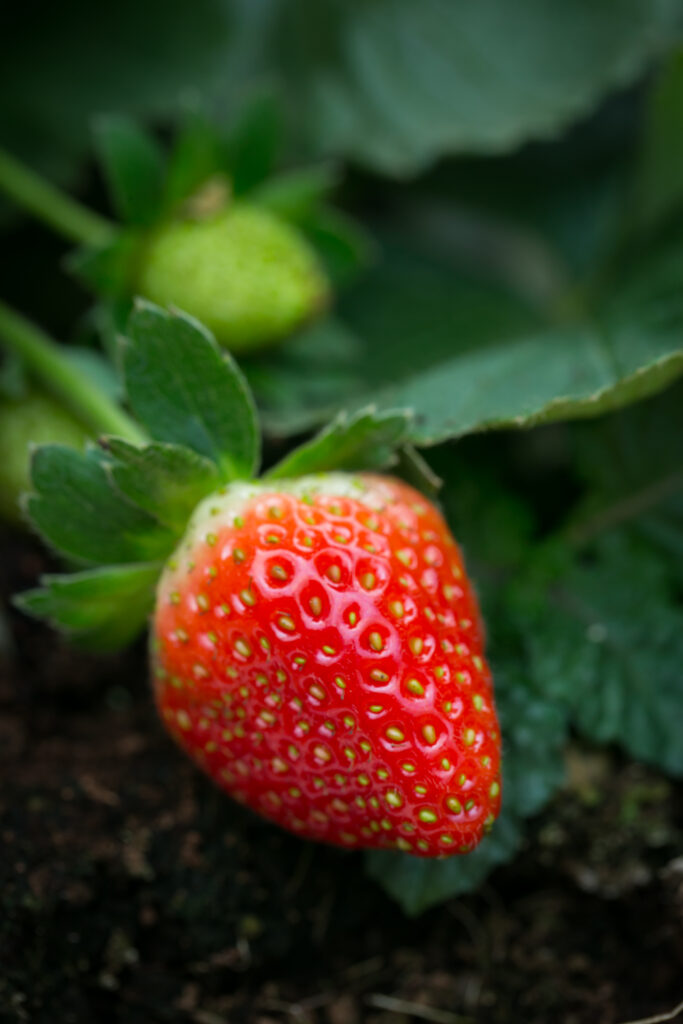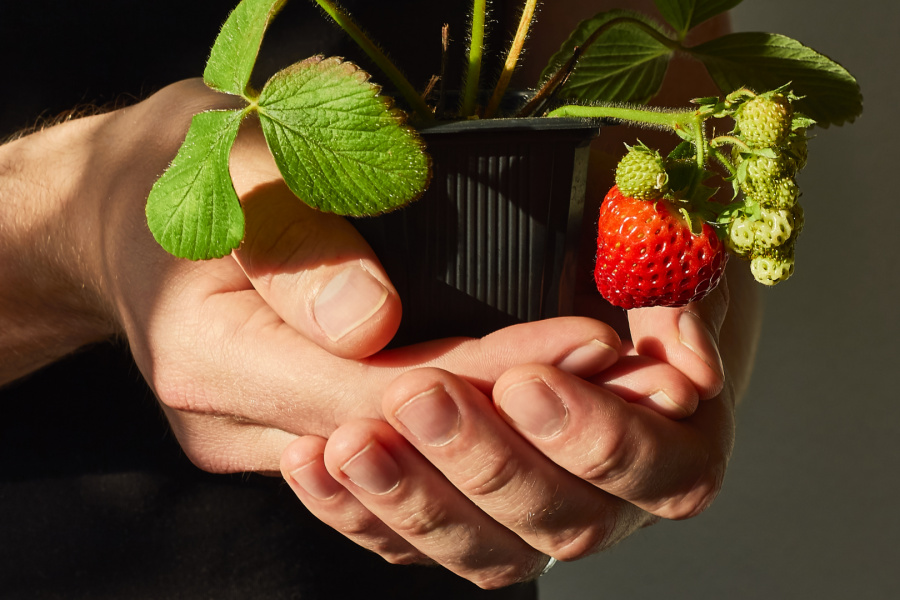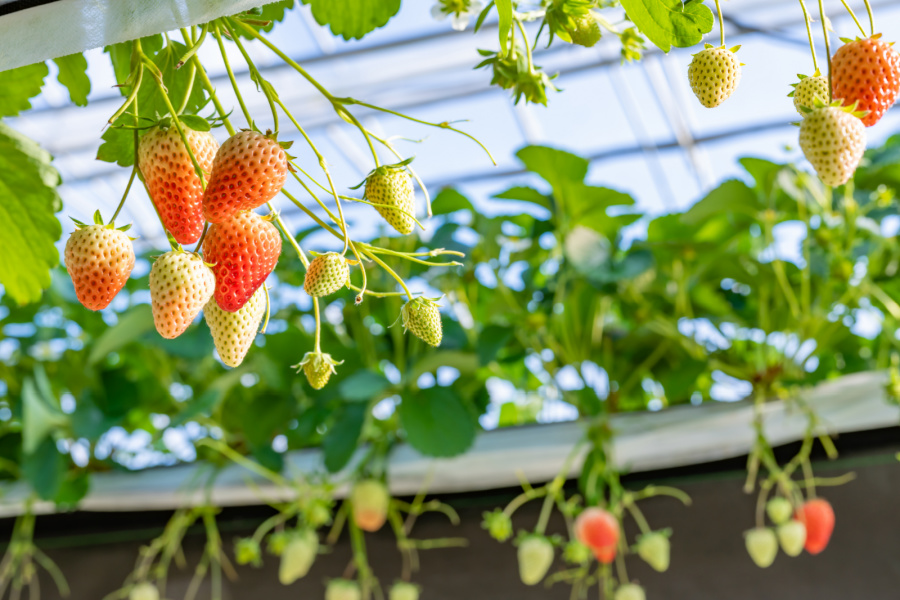A strawberry is one of the world’s most popular and healthiest fruits. Fresh, hand-picked strawberries are a delicacy, and you can use them in so many ways – turn them into jam, eat them straight from the garden, or even for your skincare routine.
You may be telling yourself that you can’t grow strawberries at home because you don’t have enough outdoor space, but you’re actually wrong! The good news is strawberries are surprisingly easy to grow both indoors and in the outdoor garden.
This post will take you through a few steps on how to plant, grow, care for, and harvest strawberries indoors.
Let’s get started!

How do I grow strawberries indoors?
Growing strawberries indoors is one of the easiest options for you. It allows you to control such factors as temperature and light and eliminates the outdoor pests whose primary purpose is to keep you from enjoying your strawberries.
If you’re not sure how to plant and grow strawberries indoors, don’t fret. Here are ten important steps to help you plant, grow, care for and harvest your strawberries indoors:
Step #1: Choose the best variety of strawberries
There are hundreds of different varieties of strawberries worldwide, stemming from a few original species. These varieties differ in size, taste, canning methods, freezing techniques, container growing, etc.
For instance, the June-bearing varieties produce large-sized berries and are resistant to soil-borne diseases. On the other hand, the sparkle varieties have an intense flavor and medium-sized fruits.
For container growing, the day-neutral strawberry plants are among the best varieties of strawberries. They’re flavorful, smaller in size, and produce sweet but small fruits.
Here are a few reasons why day-neutral varieties are the best option for indoor planting:
- They produce delicious fruits all year round in specific climates.
- They grow in the wild, where they only see a few hours of sunlight and under harsh weather conditions.
- They remain compact and doesn’t produce runner, making them ideal for limited indoor space
- They produce small but very fragrant and sweet fruits.
Among the most recommended day-neutral strawberry varieties for indoor planting is the alpine strawberry. They’re an excellent fit because they cluster together, maintaining a compact shape.
Alpine strawberries are also vigorous plants that can survive in harsh weather conditions. They’re also known for their intense flavor and fragrance.

Step #2: Choose the perfect location for your strawberry
Any vegetable or fruit plant grows the best in full sun – and the strawberry plant is not different. Place your strawberry plants close to the glass door or on a sunny windowsill.
The strawberry plant should receive at least 5-6 hours of direct sunlight. If the supply of natural light is low, place the plant under artificial light for not more than 16 hours per day.
Ensure you don’t place your plants close to hot and cool air vents of heaters and air conditioners. Also, choose an area where the plant can grow to 12 inches.
Step #3: Propagation
Propagation is the process of increasing the number of plants of a specific cultivar or species. It’s reproducing plants into new plants.
You can propagate the strawberry plant in three different ways, including using strawberry seeds, using runners, or by plant division. Let’s see how to propagate using each of these methods:
Propagating strawberries by runners
A strawberry plant produces several runners – the horizontal stems attached to plants with new strawberry plants emerging at the end. The runners develop a shallow root system and form beautiful new strawberry plants when they contact the soil.
Propagating strawberry plants by plant division
Strawberry plants may naturally put out lateral crowns at the base of the plant. These crowns can be divided and replanted to give rise to a new plant.
Also, under ideal conditions, the genetically generative strawberry rhizomes can be divided into several pieces, with each being enough to grow into a new plant.
Propagating strawberry plants with strawberry seeds
This is perhaps the easiest and most effective method of propagating the strawberry plant. It involves growing a new plant from the strawberry plant seeds.
Here are a few tips to help you prepare your strawberry seeds:
- Dehydrate a strawberry fruit. One fruit has about 200 seeds on its skin, which will be enough for indoor planting.
- Use a toothpick to remove the seeds from the dry strawberry fruit.
- Wash the strawberry seeds using cool water to remove the juice
- Dry them using paper towels
- Store the seeds in a cool, dry place. Rotate the seeds and change the paper towels until the seeds are scorched.
Note: you can buy strawberry plants from a nursery, but it is more fun and satisfying to propagate them yourself.

Step #4: Preparing the soil
Soil preparation plays a crucial role in your plant’s optimal growth. So, provide your strawberry seeds or plants with the nutritious soil they need.
The best soil type for strawberry plants is loam or sandy soil, with a little bit of clay and organic matter. Soil pH of 5.3 to 6.5 is recommended, but neutral soil can also suffice.
Organic compost, humus, peat moss, or well-rotated manure do magic when added on top of the soil. You may also add eggshells and coffee grounds to increase potassium and acidity.
Step #5: Preparing the planter or container
Your container choice may be affected by your plant’s location. For instance, if your strawberry plant will go on the windowsill, you should use a rectangular container to maximize the plant’s growing space.
On the other hand, if you have little space in your home, you may use hanging baskets. Hanging pots and baskets may also add to your home’s classy appearance.
However, whichever container you use, ensure it has drainage holes. Too much water can lead to root rot.
Strawberries have short roots, meaning a small container of approximately 5 inches will be enough. Fill the planter with about 4 inches of soil to prepare to add seeds.
Step #6: Planting the seeds
Place about two strawberry seeds in a container, spacing them at least 18 inches from each other. Overcrowding the plants can lead to fungal diseases, among other problems.
Do not bury the seeds. Instead, place them on the soil surface and put the container in an area with access to the right amount of light (ample hours of direct sunlight.)
You should see the strawberry seedlings in about 2 to 3 weeks if you follow these simple steps.
Step #7: Watering your strawberry plants
Strawberries plants are resilient, but they don’t perform well with underwatering or overwatering. Keep the soil slightly moist at all times but not overly drenched.
You may use your hands to check whether or not the strawberry plant needs watering. If there isn’t much light and the air around the plants is damp and cold, water only when the top of the soil is dry.
Morning hours are the best time for watering all plants, including strawberries. Don’t forget to use a container with good drainage
Step #8: Fertilize your strawberry plants
Like most indoor plants, the strawberry plants are hungry and thrive when fed with fertilizer. Use fertilizer every two weeks when the plant begins to grow a flower for the best results.
Choose organic fertilizer that’s safe for strawberry fruits. You don’t want to add chemicals to the fruits you’ll eat later.
Minimize the fertilizer dose and increase the duration between consecutive feeding when the plants begin to show symptoms of overfertilization. This includes brown leaf tips, yellowing leaves, or several dead leaves.
Step #9: Harvesting your strawberry fruits
You should have ripe strawberries a month after fertilizing if you follow these steps. The best thing to do with the ripe fruits is to harvest them and enjoy them in a strawberry shortcake or however you like them.
Don’t forget that over-ripe strawberries rot easily and attract insects, so harvest them as soon as they ripe.
You may store your fresh strawberries in the refrigerator to preserve them for a long time. Remember to wash them before using them.
Step #10: Repeat the process.
Want to enjoy the fruits all year long? Repeat the process in early summer and Spring.
Other care tips
Here are a few more tips for caring for your strawberry plants:
Tip #1: Pests and Diseases
Perhaps the best thing about indoor strawberry plants is that you don’t have to worry about pests and diseases. However, you still need to watch for common garden pests like aphids and spider mites.
Tip #2: Pruning
Prune the runners when they appear to direct the plant’s energy on the growth and production of more fresh strawberries. Also, do away with the unwanted flowers and dead leaves.
Prune your indoor strawberries after the fruiting season. You can remove all the foliage except the central young leaves.
Tip 3: Pollination
Remember, there are minimal or no agents of pollination in the house, so it’s for you to pollinate the strawberry flowers. Use a soft brush to transfer the pollen from one flower or plant to another.
The bottom line
Strawberries have innumerable benefits to the human body, from supplying it with Vitamin C to protecting your heart and increasing the good cholesterol in the body. This post provides you with steps and tips to grow your own strawberries at home.
Good luck as you purpose to use it to harness the benefits of Strawberries.
Leave a Reply